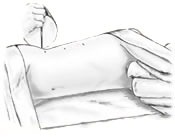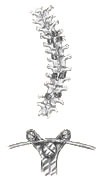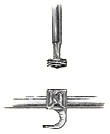Anterior & Posterior Approach to Spinal Surgery
What is it?
There are a variety of different approaches to correction of spinal deformity. Surgeons make decisions regarding the type of surgery that is appropriate for your case depending on the type, severity, and location of your particular spinal curve. In certain types of deformity, your surgeon may recommend that you have what is termed a "front and back" or anterior-posterior spinal surgery.
 Incisions
Incisions
 Disc Removal
Disc Removal
 Hooks, Screws & Rod Placement
Hooks, Screws & Rod Placement Final Tightening
Final TighteningWhy is it done?
Anterior and posterior surgery is generally recommended for curves that are very severe, stiff, or when you have failed previous attempts at fusion.
The Operation
The first thing that happens after you enter the operating room is that your anesthesiologist will help you to fall asleep. Once you are completely asleep, the anesthesiologist will place a breathing tube to assist with your breathing during surgery, establish a variety of catheters in your veins, and often an arterial catheter in your wrist, all of which allow for monitoring of heart function, blood pressure, fluid status, and the depth of anesthesia during your operation. This allows the anesthesiologist to be sure that you remain completely asleep during the operation.
Incision
Anterior and posterior surgery requires that the surgeon will first approach your spinal column from the front. In order to do this, the surgeon will usually make an incision on your side. The surgeon will then remove the disc material from between the vertebrae in the most severe part of your curve to make your curve more flexible and facilitate fusion. This part of the procedure often requires removal of a rib that is then used for bone graft.
After the anterior part of the procedure is completed, the wound is closed and you are then positioned for the "back" or posterior part of the procedure. The deformity is then corrected with placement of spinal instrumentation in your back followed by a posterior fusion.
Hooks, Screws and Rod Placement
Correction of the scoliosis requires that the surgeon be able to "grab on" to the spine. There are a variety of ways to do this. Technically, the surgeon may choose to use hooks that attach to the back of the spine on the lamina, pedicle screws that are placed into the pedicle in the middle of the vertebra, wires, or other devices. Once these connection points are established, then a rod that has been bent or contoured into a more normal alignment for the spine can be attached and correction performed.
Final Tightening
When all of the implants are securely in place a final tightening is done.
Incision Closure
The incision is closed and dressed. Some surgeons may choose to place a drain into the wound after the surgery to protect the incision. Patients wake up in their hospital bed lying on their back. Most patients who have had anterior and posterior surgery will require care in the Intensive Care Unit after surgery.



